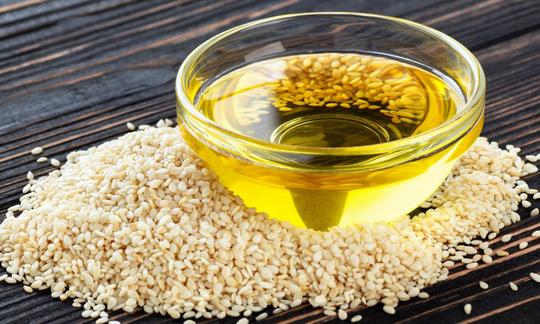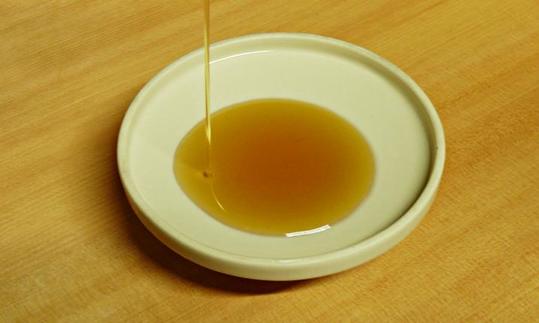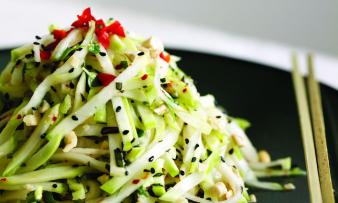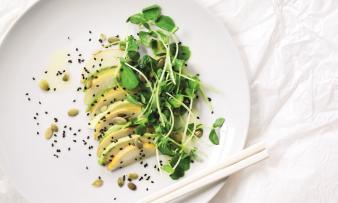Table of contents
Light sesame oil , sometimes also known as gingel oil, is made from sesame seeds ( Sesamum indicum ). In comparison to dark sesame oil , which is made from roasted seeds and thus has an intense nutty flavor, it is almost odorless.
Use in the kitchen:
Natural sesame oil is very popular in Asian and oriental cuisine. Native, cold-pressed sesame oil is very high quality and has a very long shelf life thanks to the antioxidants it contains. 1
Although cold-pressed, unrefined sesame oil has a high smoke point of 177 °C, it should only be used for cooking, steaming or sautéing (brief frying). In Asian countries, refined sesame oil is also used for baking or frying, as the smoke point increases to 232 °C. However, a longer heating phase can lead to the formation of trans fats due to the high proportion of unsaturated fatty acids.
Light sesame oil has a mild taste of sesame and is rather odorless and tasteless. It is therefore also suitable for preparing salads or in combination with fruity desserts. The slightly nutty taste also refines dips, sauces and spreads.
In addition to margarine 2, sesame oil is also used to make the sweet oriental speciality halva and other confectionery products, which, however, is very dangerous to health.
Please note that natural seeds or nuts are always healthier than the oil pressed from them!
Vegan recipe for rice salad with mango, tofu and sesame oil:
Ingredients for 4 servings: 150 g brown rice , 150 g smoked tofu , 2 tbsp sunflower seeds , 2 mangos , 2 red onions , 75 ml orange juice , 2 tbsp dark soy sauce , 2 tbsp light sesame oil, 2 tbsp light soy sauce, if desired salt ,pepper , garden cress .
Preparation: Steam the rice and let it cool. Cut the smoked tofu into small cubes and marinate in 2 tablespoons of dark soy sauce for about 30 minutes. Roast the sunflower seeds in a non-stick pan without fat. Peel the mangos and onions and dice them finely. Mix the onion pieces with the light soy sauce, orange juice and sesame oil. Then mix everything together and season with salt and pepper if necessary. Arrange on a plate and sprinkle with cress and sunflower seeds.
| Not only vegans or vegetarians should read this: Vegans often eat unhealthily. Avoidable nutritional mistakes . |
Shopping - where to buy?
Some supermarkets such as Coop , Migros , Spar , Rewe or Edeka have refined sesame oil in their range. Discounters such as Denner , Volg , Aldi , Lidl , Hofer etc. have less of this oil - or only at special offers. Cold-pressed, virgin sesame oil is available in health food stores, organic shops or online. Drugstores also have this oil, but sell it as a cosmetic oil for skin and hair.
Some organic associations also do not allow gentle steaming/deodorization, refining, neutralization or bleaching of cooking oils. The heating of raw materials and the outlet temperature during pressing must not exceed 50 °C.
Variants of sesame oil:
Cold-pressed sesame oil is produced without the addition of heat. Larger particles are removed by repeated filtering. This gentle process guarantees that the valuable ingredients are preserved. Organic and virgin sesame oil remains natural and unfiltered. These oils are pale yellow.
Cold-pressed oils (laws, raw food)
In Switzerland, oil is referred to as cold-pressed oil if the oilseed was not heated, the pressing temperature did not exceed 50 °C and no problematic post-treatment took place.
According to the Federal Department of Home Affairs ( FDHA ), an edible oil is considered cold-pressed (or may be described with synonyms such as (extra) virgin, unrefined, cold-pressed or natural) if it has been obtained by pressing or centrifuging from previously unheated raw materials, the temperature during pressing did not exceed 50 °C and it has not been subjected to refining, i.e. no neutralisation, no treatment with adsorbents, bleaching earth or steaming .
An oil may be described as “gently steamed” if the refining process was limited to steaming and the temperature did not exceed 130 °C . 25
In the EU and the USA, there does not appear to be a generally applicable temperature limit for cold-pressed oils. For example, the guidelines for edible fats and oils of the Federal Ministry of Food and Agriculture (D) are similar to the EDI regulation, but they do not specify a permissible maximum temperature for general cold pressing - since they only apply to products whose labelling and composition are not conclusively defined by law (i.e. not for olive oil, cocoa butter, milk fats, spreadable fats, for example). 26
On the other hand, both the EU directives and the amendment to the EDI regulation on foods of plant origin, mushrooms and table salt (and its amendment) provide for a special rule for the labelling of olive oils . 27,28
These are selective marketing rules in which the term raw food is not defined. "Raw food" and "raw" are therefore not state-protected terms (as is the case with the term "organic"), which leaves a lot of room for interpretation. Although it is agreed that with purely mechanical cold pressing, the pressing temperatures generally do not exceed 40 °C, one should not naively assume that cooking oils are raw food quality. There is a suspicion that the measuring method used does not indicate the temperature in the press cylinder (where the heat is highest), but only the outlet temperature in the oil hose. With water-cooled olive oil presses (so-called "water-cooled 37°" oil presses), one probably cannot even say with certainty what the exact temperature is inside the press cylinder, because the entire press cylinder is surrounded by cooling sleeves.
In addition, the pressing pressure and speed as well as the moisture content of the oilseed affect the pressing temperature. If, for example, the moisture content is too low, the temperature rises during pressing and it is difficult to stay even below the maximum limit of 50 °C. 29
Unrefined sesame oil is first pressed "cold", but temperatures can still reach up to around 60 °C. Steaming after the pressing process increases the shelf life, but also reduces accompanying substances such as ingredients, odors and flavors. 21,22
Refined sesame oil is heated to over 100 °C during pressing. During the steps of degumming, deacidification, deodorization, bleaching, fractionation, etc., almost all of the odor and flavor are lost: the oil has a longer shelf life. There is also the term "semi-refined," in which only some of the steps mentioned are used (e.g. degumming). 20
There is also cold-pressed sesame oil made from pure black sesame seeds . It is very similar in color to the oil made from light seeds.
If you roast the seeds before pressing, the pressed oil will be amber-colored and have a strong, nutty flavor. It is only used to refine dishes and never for heating. Sesame oil made from roasted seeds is available in Asian shops, usually in small portion bottles. In East Asia it is also dark brown.
Indian sesame oil is also called gingelly or til oil; it is golden.
Storage:
The antioxidants contained in sesame oil naturally protect it from spoiling. It can be stored for a very long time if it is well sealed and in a dark bottle protected from light. But even an opened bottle can still be kept in the refrigerator for 12-24 months. Cold-pressed oils can become cloudy or form flakes in the refrigerator. This is a natural reaction and does not represent a reduction in quality.
Ingredients - nutritional value - calories:
Sesame oil consists almost exclusively of fat and has a calorie content of 884 kcal/100g. 3 The proportion of saturated fats is around 14%, the unsaturated fatty acids predominate: polyunsaturated fatty acid ( linoleic acid ) with around 41%, monounsaturated fatty acid (oleic acid) with around 38% (fluctuation range between 28 and 44% 23 ), < 1% polyunsaturated fatty acid ( alpha-linolenic acid ). Sesame oil also contains palmitic acid, myristic acid, stearic acid, etc.
Sesame oil does not contain many vitamins, but two of them are detectable. Vitamin K is present in sesame oil at 14 µg/100g. Walnut oil has a similar content (15 µg), and rapeseed oil has even more at over 70 µg. This fat-soluble vitamin is important for blood clotting and bone metabolism. 3
Although sesame oil only contains 1.4 mg/100g of vitamin E , the oil has more than twice as much of it as the healthier linseed oil (0.06 mg/100g). Wheat germ oil probably contains the most at 149 mg/100g, but hazelnut oil is not bad either at 47 mg. Alpha-tocopherol acts as an antioxidant on the lipid layers of the body's cells. 3 The recommended daily dose for an adult is 12-14 mg. 4
You can find all the ingredients, the coverage of the daily requirement and comparison values with other ingredients in our nutrient tables. In the article Nutrients explained you will get a detailed insight into the topic.
Health aspects - effects:
How healthy is sesame oil? There are some contradictions here: On the one hand, sesame oil has a very poor ratio of omega-6 to omega-3 fatty acids (138:1). The predominant linoleic acid here promotes inflammation in the body. Cold-pressed linseed oil (1:4) or rapeseed oil (2:1) have a much better LA:ALA ratio. Read more about this in the box link above.
On the other hand, there are the following positive studies on the ingredients of sesame oil:
The antioxidants contained in sesame oil, such as sesamol and sesamolin, not only counteract rancidity 5 , but in combination with alpha-tocopherol are said to protect against age-related kidney dysfunction. 6
If you use sesame oil in combination with rice germ oil as a cooking oil, you can lower your blood pressure and cholesterol. 7 Unfortunately, there has been very little research into whether the lignan sesamin really has this LDL cholesterol-lowering effect. 8 However, it can increase the effect of blood pressure-lowering medication. 9
The water-soluble components in sesame oil reduce inflammation and act against atherosclerosis. 10
Please always remember that every oil consists of almost 100% fat. The health-promoting components it contains are very small, relative to the amount you consume daily.
Dangers - intolerances - side effects:
Since sesame is one of the strong allergens that must be declared, this also applies to sesame oil. However, there are only very few people who are allergic to it (0.1%). 11 There are also reactions to the oil in the form of allergic contact eczema. It is suspected that this is a hypersensitivity to lignin-like ingredients. 12
Folk medicine - natural healing:
Oil pulling is well known in Russia and many Asian countries and is used for oral hygiene. This detoxification method is also carried out with sesame oil. Studies show a reduction in the number of bacteria of the species Streptococcus mutans 13 in the mouth and a reduction in bad breath. 14
Sesame oil is used in the elderly in cases of dry constipation, but it is also used to treat burns, scalds and ulcers. 15
Many traditional natural healing methods use sesame oil to improve the skin's appearance, to treat dry noses and as an oil treatment (Ayurveda). The oil feels very pleasant on the skin, does not leave a greasy film and makes the skin soft and supple. It is also said to contain a natural sun protection factor and protect the skin from UV rays (30%). 16,17
Occurrence - Origin:
Sesame is one of the oldest oil plants used by humans. The "gene center" of sesame cannot be clearly identified. It is believed to have originated in southeast Africa, as many wild species can still be found there today. A domestication of Sesamum indicum from 2350 BC was found in the Middle East, more precisely in the former Mesopotamia (Mesopotamia). 5 Today, sesame plants are grown in many tropical and subtropical regions.
Cultivation - Harvest:
Sesame requires very warm, sunny locations with nutrient-rich, permeable soil. The rapid growth of this oil plant makes it very popular in tropical areas. In addition, the taproot, which reaches up to 1 m deep into the soil, helps it survive dry periods. 5
The annual sesame plant reaches a height of 1-1.5 m, depending on the variety. 18 Some wild forms even grow up to 2 m high.
The fruits are 3-4 cm long capsules that contain around 80-100 seeds with a maximum size of 3 mm. After 120 days of constant temperatures of over 25 °C, the seeds are ready for harvest. The ripe capsules burst open, but unfortunately many seeds are lost before harvest. The plants are therefore harvested before they are fully ripe and hung up to dry. 24 Through targeted breeding, the capsule closure has been improved, thus ensuring a consistent harvest. 5
There are white, yellow-brown, reddish or black sesame seeds.
Danger of confusion:
The plant Sesamum indicum looks similar to the foxglove genus ( Digitalis ) with its bell-shaped flowers.
Animal protection - species protection - animal welfare:
Bees are important for a high yield in the cultivation of sesame and cotton. This was the conclusion reached by biologist Dr. Katharina Stein from the University of Rostock in West Africa. Targeted pollination can increase yields by up to 60%. But wild and honey bees are also at risk in the tropics and without them there could be harvest losses of up to 59% for sesame. 19
General information:
Sesame oil is made from the white and black seeds of sesame. The production of light sesame oil is similar to that of other vegetable oils. According to Wikipedia , one ton of sesame produces around 300 liters of oil.
Alternative names:
An alternative name for sesame oil is gingel oil, in English it is called sesame oil, til oil, benne oil or gingelly. You can also find the term gingili for Indian sesame. 15
Drug name: Sesami oleum. 18
Other uses:
The skin-care properties, the special composition and the delicate scent of sesame oil also make it interesting for the cosmetics and perfume industry. Sesame oil is a component of skin care products, is used in the production of vegetable soaps, as an additive in soaps and as a lubricant. 15
The press residue, known as sesame cake, is a very high-quality animal feed due to its high protein content of 40%. 5
Literature - Sources:













Comments